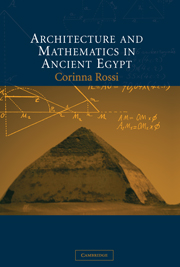Book contents
- Frontmatter
- Contents
- List of illustrations
- List of tables
- Preface
- Acknowledgments
- List of abbreviations
- Part I Proportions in ancient Egyptian architecture
- Introduction to Part I: Harmony and proportions in architecture
- 1 In search of ‘the rule’ for ancient Egyptian architecture
- 2 Mathematics and architecture in ancient Egypt
- Conclusion to Part I: Ancient mathematics and practical operations
- Part I Ancient Egyptian sources: construction and representation of space
- Part III The geometry of pyramids
- Conclusion to Part III: Interpreting the slope of pyramids
- An overview
- Appendix: List of Old and Middle Kingdom true pyramids
- Bibliography
- Index
2 - Mathematics and architecture in ancient Egypt
Published online by Cambridge University Press: 27 February 2010
- Frontmatter
- Contents
- List of illustrations
- List of tables
- Preface
- Acknowledgments
- List of abbreviations
- Part I Proportions in ancient Egyptian architecture
- Introduction to Part I: Harmony and proportions in architecture
- 1 In search of ‘the rule’ for ancient Egyptian architecture
- 2 Mathematics and architecture in ancient Egypt
- Conclusion to Part I: Ancient mathematics and practical operations
- Part I Ancient Egyptian sources: construction and representation of space
- Part III The geometry of pyramids
- Conclusion to Part III: Interpreting the slope of pyramids
- An overview
- Appendix: List of Old and Middle Kingdom true pyramids
- Bibliography
- Index
Summary
Ancient Egyptian mathematics
The mathematical sources and their language
One of the most common faults of the modern approach to the problem of proportions in ancient architecture is the adoption of a mathematical system which is chronologically inappropriate. As we have seen, many of the modern theories involving the Golden Section in the interpretation of ancient Egyptian art and architecture are based on the calculation of φ according to our mathematical system. The ancient Egyptians, however, used a different mathematical language, adopted different methods and expressed the results in a different way. If a calculation works or a pattern appears in our own mathematical system, this does not imply that exactly the same would happen in theirs. Moreover, in some cases the question to ask is not only if a method would have worked in a certain mathematical system, but also if that method would have been produced and adopted by that mathematical mentality.
Our main sources for defining the ancient Egyptian mathematical system are a number of mathematical texts written on papyri, ostraca and leather dating from the second half of the Middle Kingdom to the Second Intermediate Period (c. 1800 to 1600 BC), the most important of which are the Rhind Mathematical Papyrus (usually abbreviated as RMP), the Moscow Mathematical Papyrus, the Kahun Papyri and the Egyptian Mathematical Leather Roll.
- Type
- Chapter
- Information
- Architecture and Mathematics in Ancient Egypt , pp. 57 - 86Publisher: Cambridge University PressPrint publication year: 2004



